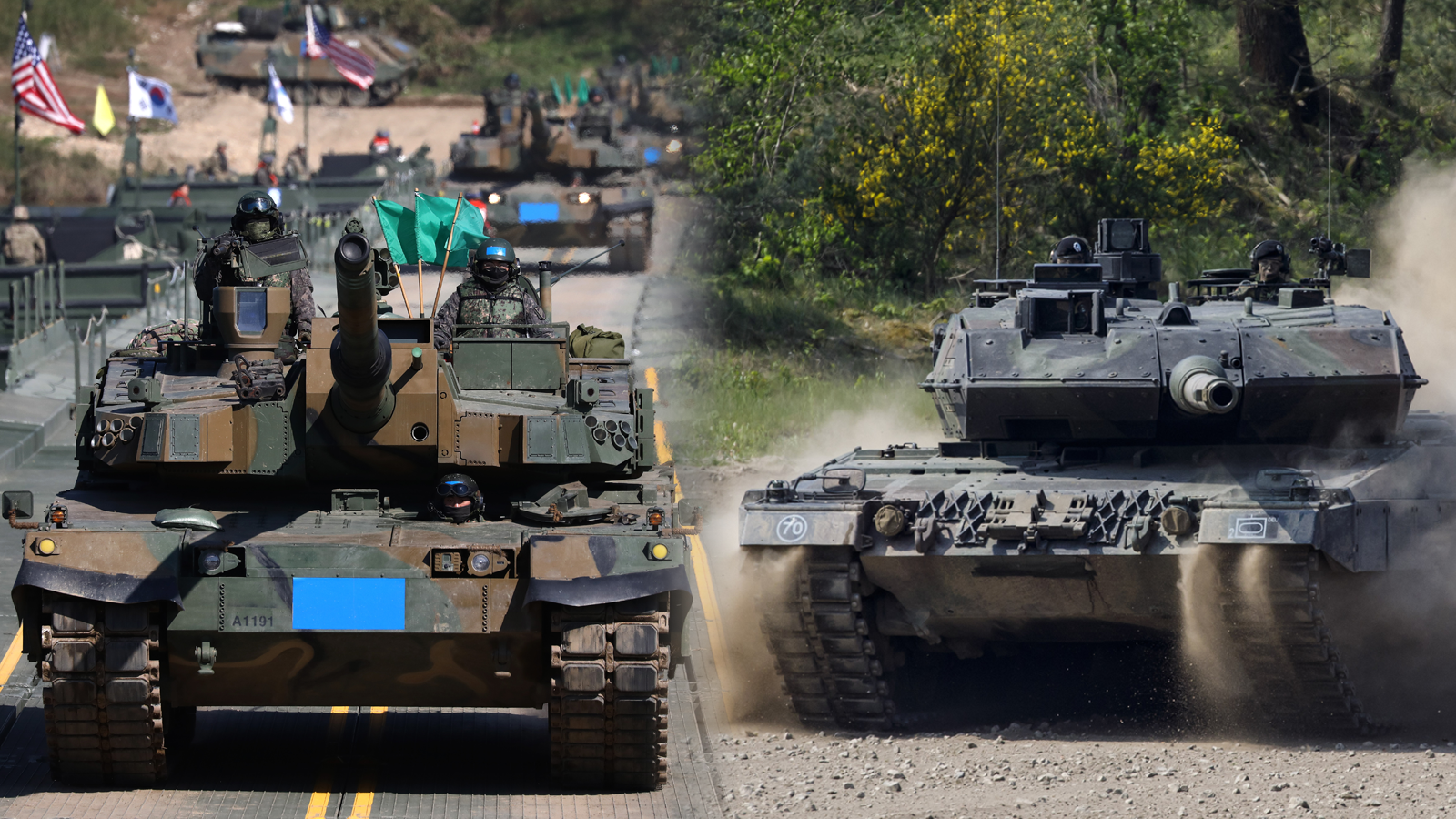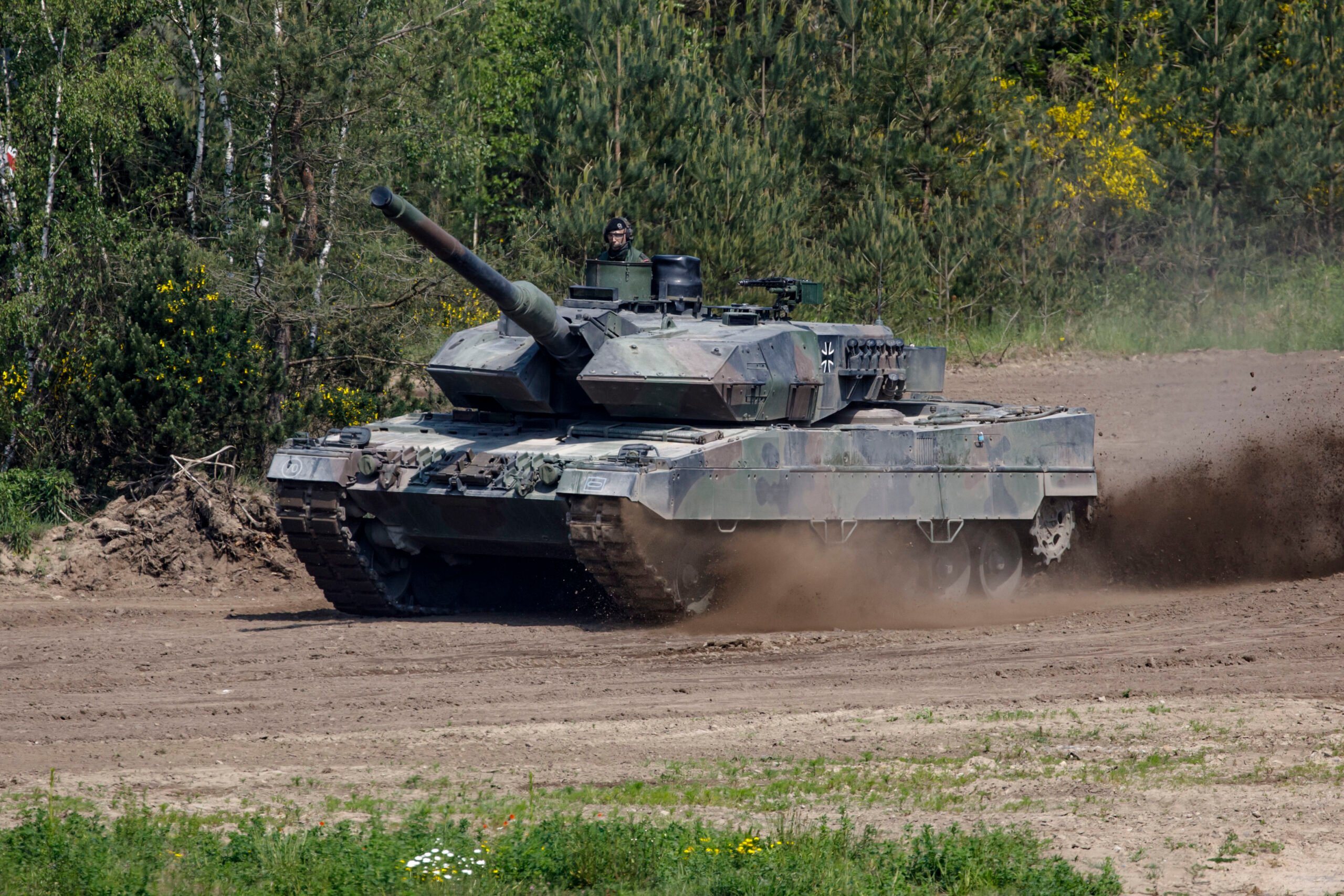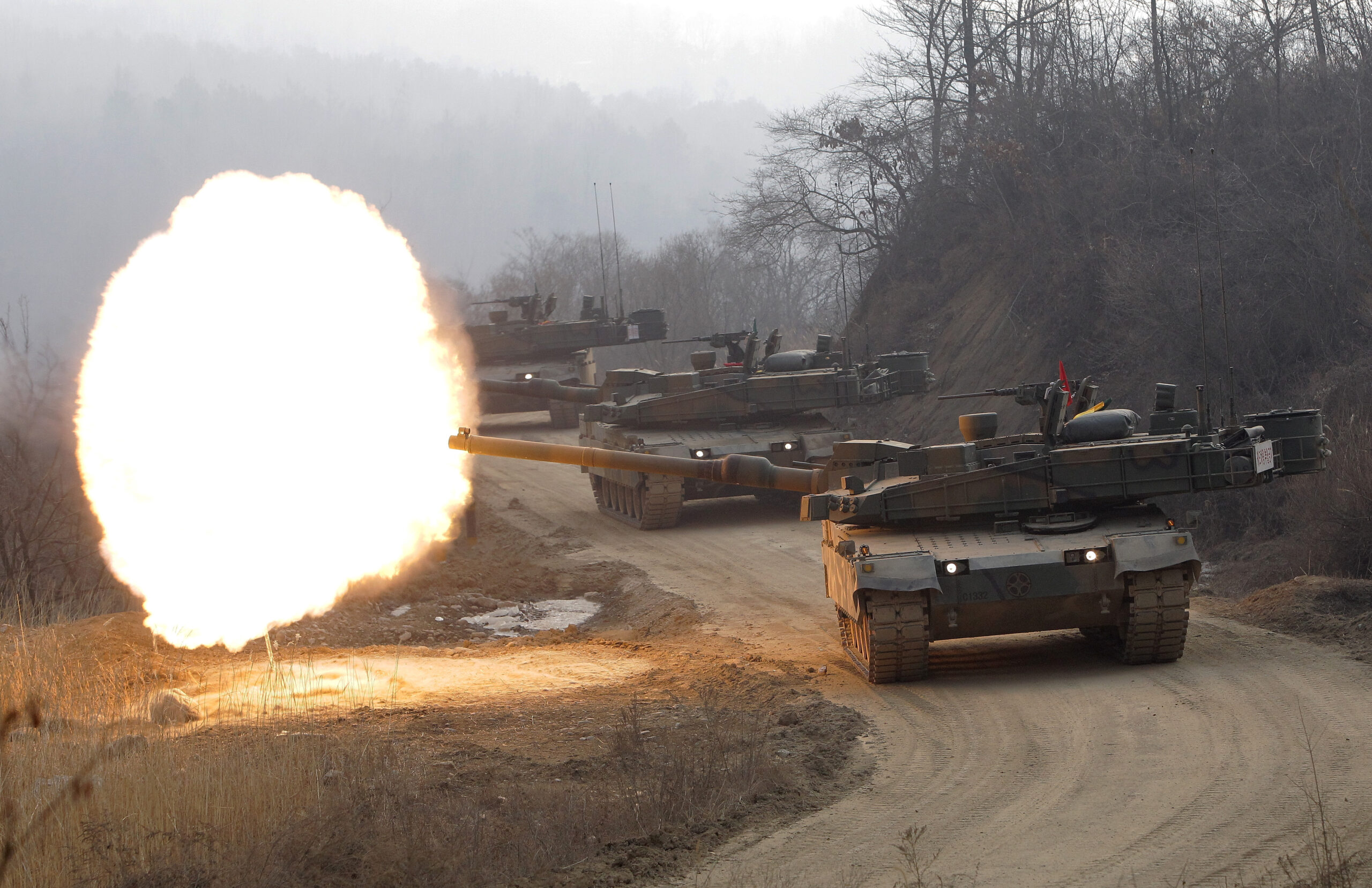SÉBASTIEN ROBLIN
 NEW YORK — As Russia’s war in Ukraine enters its second year, a different, much more welcomed mechanized invasion is taking place next door, as the first of potentially 1,000 South Korean-designed main battle tanks pour into Poland. This is a result of a $14.5 billion arms deal by Warsaw, which if fully optioned, could see Poland eventually receive more tanks than are currently operational in the armies of the United Kingdom, Germany, Italy and France — combined.
NEW YORK — As Russia’s war in Ukraine enters its second year, a different, much more welcomed mechanized invasion is taking place next door, as the first of potentially 1,000 South Korean-designed main battle tanks pour into Poland. This is a result of a $14.5 billion arms deal by Warsaw, which if fully optioned, could see Poland eventually receive more tanks than are currently operational in the armies of the United Kingdom, Germany, Italy and France — combined.The first of 180 Hyundai K2 Black Panther tanks which began arriving in Poland in December 2022 are “gap-fillers” pulled from ROK Army units for rapid delivery. Poland then plans to domestically manufacture the remaining 820, starting in 2025/2026, as well as establish maintenance and spare parts depots.
Somehow, 1,000 tanks is just part of the major buy of South Korean gear that Poland has made in the last year. That series of packages includes 672 South Korean K9 self-propelled howitzers (two-thirds to be locally produced), 48 FA-50 light fighter jets, and 288 K239 Chunmoo multiple-rocket launchers custom-mounted on Polish 8×8 trucks. Warsaw is also considering purchasing Hanwha’s AS-21 Redback infantry fighting vehicles to replace its dated BWP-1s.
It hasn’t escaped observers that South Korea’s big splash into Poland could spill over into other European states. Many were frustrated by Berlin’s reluctance in 2022 to authorize transfers of Leopard 1 and 2 main battle tanks to Ukraine and the slow pace of deliveries of new ones.
In an article for Foreign Policy, defense analyst Blake Herzinger argued the South Korean-Polish team-up could “sweep up” Germany’s seemingly assured dominance on Europe’s main battle tank market. Jakub Bornio, writing for the James Town Foundation, similarly noted the Seoul-Warsaw relationship could result in a “win-win situation, with Warsaw boosting its military potential and reviving its heavy military industry, on the one hand, and Seoul solidifying its position in the European and global defense markets, on the other.”
Still given Europe’s many Leopard 2 operators, how real is the threat of a Black Panther invasion? Experts on the defense industries of Germany, Poland and South Korea are, at least for the moment, skeptical a wholesale switch from German to Korean tanks is in the offing, both for geopolitical and operational reasons.
Poland And The Black Panther
The Leopard 2, which entered service in 1979, is a heavy tank with advanced composite armor and fire control overmatching Soviet weaponry. With the end of the Cold War, Germany retired thousands of Leopard 2A4 tanks and offered them for sale at bargain prices. When manufacturer KMW introduced the better armored Leopard 2A5, and further up-gunned 2A6 and 2A7 models, these vehicles appealed to operators familiarized with the 2A4, which could be remanufactured to the new standard.
Poland purchased 142 Leopard 2A4s and 105 Leopard 2A5s in 2003 and 2013. However, Warsaw wanted to inject new life into its defense industry by receiving a share of production. But while Germany and Poland arranged for upgrades to Polish 2A4s, Warsaw was unable to gain entry into the next-generation French-German Main Ground Combat System (MGCS) program despite a final push in early 2020.
Poland then began considering South Korea’s new K2 tank, offered with the sweetener of domestic production and tech transfers. But it instead bought 250 M1A2 Abrams tanks from the United States. Following Russia’s invasion of Ukraine, Poland donated over 300 T-72M and PT-91 tanks from its army and rush-ordered an additional 116 retired U.S. Marine Corps M1A1 tanks as a stopgap. But when Warsaw asked for more Leopard 2s, Berlin couldn’t assure new deliveries until 2023.
“Germany offered to deliver one Leopard 2A7 to the Poles a month [in 2023],” said Edward Kim, an expert on South Korea’s defense industry. “That was the final straw since the Koreans promised to deliver 980 K2s within five years.”

A Leopard Tank of the Bundeswehr Panzerlehrbrigade 9 (9th Armoured Demonstration Brigade) during a presentation of capabilities by the unit on May 20, 2019 in Munster, Germany. (Morris MacMatzen/Getty Images)
Putin’s invasion created the political will in Warsaw to go big on the K2, Kim said, with the choice hinging on three key points.
“First, the K2 is close enough in terms of capabilities. Second, it’s considerably cheaper per unit. And third, the Koreans are promising quick delivery and comprehensive parts and tech transfers,” he told Breaking Defense. “The fact that Poland will probably end up having a large Maintenance, Repair and Overhaul facility and parts manufacturing and distribution center for the K2 (and K9 artillery and FA-50 fighter) is going to be a big selling point for Scandinavia, Eastern Europe and the Baltic states.”
However, Krzysztof Kuska, an expert on Poland’s defense industry, urged caution about forecasting exports of the Korean-designed, Warsaw-built tank so early. “Poland is in urgent need of tanks and South Korea has the capabilities to deliver. This seems to be the main factor…If the whole batch is bought and a production line of K2 gets established in Poland than the K3 [successor] made in cooperation will be more probable.”
Defense journalist Robert Czulda observed in article that how Poland will finance these purchases is far from clear, with Poland’s own defense industry already suggesting it may domestically build only 500 K2s. Even if Warsaw does fully follow through on its plans, it could take many years before future Polish K2 factories could pivot towards fulfilling export orders.
Nicholas Drummond, a consultant for KMW, argues Poland’s split with the Leopard 2 was due to lingering distrust going back to World War II, but concedes that Germany’s conflicted pre-2022 relationship with Russia undermined its defense sector.
“Prior to the [2022] Ukraine War, Germany was a very unreliable defense partner…In the last 12 months, we have seen a 180-degree shift in German government attitudes. Germany has changed.”
Negotiations at the “Free the Leopards” summit on Jan. 20 were highly contentious, but Berlin’s about face just days later has dispelled much frustration accumulated in 2022. Berlin and Warsaw are now the two largest donors of Leopard 2 tanks to Ukraine. That makes Poland’s motivation for turning to Seoul seem less salient to future exports—if German factories can actually deliver new tanks faster. That reportedly hasn’t changed yet due to a lack of large-scale governments orders with which to compel factories to expand their production capacity. Gustav Gressel, a senior policy fellow of the European Council for Foreign Relations argues large-scale government spending and procurement is needed to increase the Leopard 2’s current delivery rate of two per month for new vehicles.
Leopard And Black Panther Compared
A notable early skirmish between Leopard 2 and Black Panther took place in Norway, which evaluated both types for cold weather operations in 2022. Kim said those tests showed “the K2 compares rather favorably to the Leo 2A7. As predicted the Leo 2A7 does have better overall armor, but the Koreans mitigate that by offering up-armored versions for both the Poles and the Norwegians.”
Drummond concurred: “Fundamentally, the K2 replicates the Leopard 2’s concept and design by adopting the same approach to combat operation. Both are excellent tanks. Both are designed to be operated by conscript armies…Hyundai Rotem added key enhancements to the basic configuration, including an autoloader and variable suspension, that are interesting and valid.
But in February, Oslo decided to order 54 Leopard 2 A7Vs for $1.9 billion — even though some Norwegian media alleged the military had recommended buying K2s due to lower cost and faster delivery rate.
Of course, any major arms buy is also a geopolitical signal. As Kuska put it, “…small differences [in capability] might not be that important on the battlefield and a bonus of tighter connections with a close neighbor is always more favorable than an alliance with a distant partner such as South Korea.”
Core capabilities the tanks share include stabilized 55-caliber 120-millimeter main guns which can reliably penetrate opposing Soviet/Russian tanks at long range and hit while moving; high-magnification day/night sights for gunner and commander linked to allow “hunter killer” engagement of multiple targets in rapid succession; and multi-layered front turret armor that can withstand most Soviet/Russian anti-tank missiles and shells.
Still, it’s possible to consider distinguishing points without succumbing to the narcissism of small differences. The 67- to 73-ton Leopard 2A7 and 61-ton K2 were designed to fight defensive wars in different places. The German design was built to thwart Soviet tanks in a freewheeling battle across the open terrain of Western Germany, while post-Cold War models improved all-around protection to minimize vulnerability to mines and ambushes in urban/counter-insurgency environments.
The K2, meanwhile, was engineered for a slugfest along the mountainous demilitarized zone between North and South Korea, where constrained maneuverability reduce exposure to flank attacks. This led the K2’s designers to skinny downside and rear armor to save weight. However, Poland, like Germany and Ukraine, has lots of open ground, and Poland’s customized K2PLs will feature added tons of reinforced side/rear armor.
The mountain terrain focus is also reflected in the K2’s dynamic hydropneumatics suspension, which allows raising or lowering the elevation of each side of the tank. Thus, a K2 can “crouch” in a side-tilted position, kneel down and depress its gun to -16 degrees to engage targets far below, or angle upwards to arc shots up to 3 miles away.
However, a German Panzergrenadier (mechanized infantry) officer who spoke to Breaking Defense under condition of anonymity dismissed it as “…a party trick. A lot of extra complexity for a few extra degrees of depression/elevation when you could just use a slope.”
Another difference is the K2’s three-person crew to the Leopard 2’s four, because the former’s CN08 smoothbore gun uses an autoloader (allegedly patterned from France’s Leclerc tank) instead of a human loader. Human loaders bring some added utility and speed, but next-generation Western tanks will likely use autoloaders to save space/weight.
The K2 can also employ a gun-launched anti-tank guided missile (GLATGM), which unlike Soviet/Russian-style GLATGMs, is a fire-and-forget top-attack weapon. KSTAM has a maximum range of 5 miles and can perform indirect fires and engage low-flying helicopters.
Tanks in Ukraine have made extensive use of GLATGMs and indirect fires, which KSTAM combines in one package. However, the Panzergrenadier officer observed KSTAM, like the Israeli LAHAT, has yet to be procured for operational service. He pointed out that compared to same-diameter kinetic sabot shells, GLATGMs take much longer to reach their targets and are less likely to penetrate. And if employed for more effective top attacks, have reduced range.
A notable asterisk with the K2 concerns its powerpack, which presently retains German-built Renk transmission as in the Leopard 2. While Hyundai has designed an indigenous EST15K transmission, the powerpack failed to pass a 10,000-kilometer breakdown-free trial in 2020, and was not accepted into South Korean service.
However, the South Korean powerpack has been deemed acceptable for integration into Turkey’s Altay main battle tank, while a revised EST15K transmission will be evaluated this year by Seoul.
Tank Battle On A Logistical Battlefield
Drummond argued the real vital difference between the tanks wasn’t “combat performance”, but rather from Leopard 2’s maturity and extensive and experienced user base of 20 countries: “They shared the development costs, and with many user nations having their own supply chains, inexpensive spare parts are readily available from multiple sources.”
The Panzergrenadier officer, however, said that future Leopard 2A7s will likely remain brand-new production, not remanufactured:
“For the new 2A7s, it’s no longer viable from the economical point of view…the strain on the metal after enough years gets excessive, just like for aircraft. The torsion bars are digging into the hull, the steel is getting weaker and weaker. That’s why nobody is really upgrading any A4s to the A7s. Same for 2A6 hulls, because those are based on the A4s.”
The German Army is already notoriously short on spare parts to keep its vehicles operational — reportedly only two of its six tank battalions have more than ten operational tanks out of the authorized 44. And the officer expects the older Leopard 2A4’s back inventory of spare parts to rapidly dwindle, (along with those of the Marder 2 and Leopard 1) as these type begins seeing combat in Ukraine.

South Korea’s K-2 battle tanks fire live rounds during the live fire drill at the complex training field on February 11, 2015 in Gyeonggi-do, South Korea. (Chung Sung-Jun/Getty Images)
Of course, K2 infrastructure planned for Poland may eventually create a rival maintenance base. But according to a leaked presentation by Hyundai-Rotem, depot maintenance is in development until 2026, indigenous “Polonization” of K2 components will continue until 2031, and production will last through 2034 — possibly then succeeded by a jointly developed K3.
And by then, the next-generation French-German MGCS tank and a possible Abrams successor will loom as options too. Meanwhile, Hyundai-Rotem’s own K2 production line will have built only 260 tanks from 2013-2023, and will doubtlessly be occupied replacing those transferred from South Korea’s military to Poland.
Germany therefore retains big advantages persuading fellow NATO members to buy improved versions of a tank many are already familiar with and can reuse at least some spare parts for. But can KMW deliver new Leopard 2A7s more rapidly?
Drummond insists it can: “Production capacity isn’t an issue. KMW’s factory was producing 16 Leopard 2s per month [ie. 192 per year] at the height of the Cold War. It still has the same floor space while it has embraced new manufacturing techniques. If there are any bottlenecks to delivery, these come from the supply chain not the original equipment manufacturer.”
Another chart implies annual production peaking at 300 per year in Germany, with another 144 built in a Dutch factory. Later, there has been Leopard 2 manufacturing and assembly in Greece, Hungary, Spain, Sweden and Switzerland.
It’s notable that Seoul, which has exchanged defense technology with Russia in the past, hasn’t authorize direct arms sales to Ukraine, though some munitions may be delivered to Ukraine via third parties. Reports indicate South Korean reticence is likely to persist.
Romania, another country looking to recapitalize a large tank fleet and which is reportedly already looking to purchase South Korean artillery, just decided to procure a battalion of M1 tanks. One potential European buyer is Slovakia, which in 2021 discussed a potential K2 buy at the ministerial level. But since December 2022, Slovakia and the Czech Republic have each begun receiving 15 Leopard 2A4s from Germany to compensate for armored vehicle donations to Ukraine, with Prague optioned to potentially buy 50 brand-new 2A7s as well.
Kuska put it this way: “I think that in Europe it will be difficult to push the K2 at least in the near future. Maybe when Poland will have a well-established tank component with a huge amount in service, it will be easier [to find export clients]. At this point Germany still has the upper hand as it is the dominant economic power on the continent with huge influence in the EU. So for smaller nations it is better to stick to the Leopard 2 and Germany than make a switch to South Korea and their K2.”
No comments:
Post a Comment